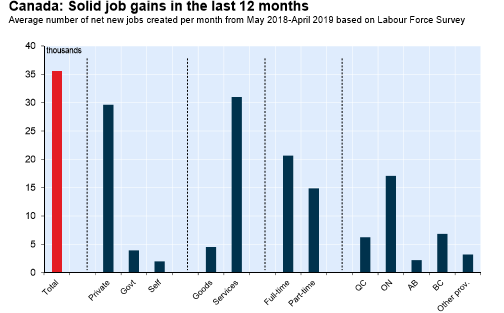Canada’s Job Market Continues To Outpace The Economy
“Even though (Canadian) real GDP growth was weak again in Q1, recent job trends suggest that the broader economy is not falling off a cliff and that the weakness should prove transitory, as we and the BoC expect”.
(Robert Kavcic, More Cdn Employment Intrigue, BMO, May 10, 2019)
The Canadian job market accelerated sharply in April by adding 106,500 jobs, which represents the most jobs ever created in a single month since data tracking began in 1976.
Literally, everyone was caught off guard by the magnitude of the job surge -- 73,000 full-time jobs and 33,600 part-time jobs.
There was a 7,200 decline in jobs in March, thus an employment rebound in April was to be expected.
Unfortunately, Canada’s monthly job numbers, which are based on the labor force survey, are known to be quite erratic. In fact, the monthly standard error for employment in April is + or- 29,600 jobs.
But even averaging the last two months together, the average of 50,000 jobs per month added to the workforce is still quite an impressive figure.
As of April, total Canadian employment over twelve months increased by 426,000 jobs (or 2.3%), with reported gains in both full-time (+248,000) and part-time (+179,000) work.
Over the same twelve months, total hours worked increased by only1.3%.
Canada’s labor force participation rate rose slightly in April, and yet the unemployment rate still managed to decline to 5.7% in April from 5.8% in the previous month. Wage growth also edged up to slightly to 2.5% y/y in April.
The employment surge in April was widely based but particularly strong in the service-producing industries, which increased by nearly 67,000 jobs. Job gains in the month were primarily due to the private sector (+84,000), although the public sector created 23,000 new jobs. Self-employment was flat in April.
Ontario (+47,000) led the nation in terms of job creation in April, followed by Quebec (+38,000), Alberta (+21,000 and BC (+6,000).
Finally, when Canadian and the American job figures are compared, there is no doubt that the US job market is much tighter than Canada’s.
For example, when adjusted to US concepts, the unemployment rate in Canada was 4.7% in April compared with 3.6% in the United States.
Nonetheless, Canada’s labor force participation rate in April (adjusted to US concepts) was higher in April than the US comparable one, 65.8% compared to 62.8%.
As well, adjusted to US concepts, the employment rate in Canada was also higher in Canada than the American, 62.7% compared with 60.6%.
(Click on image to enlarge)

(Click on image to enlarge)

(Click on image to enlarge)




